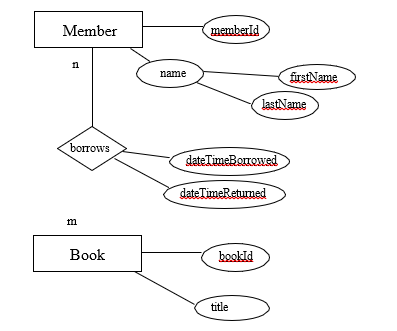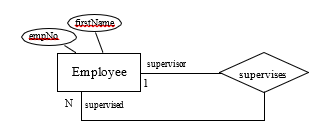8. MAPPING AN ERD TO A RELATIONAL DATABASE
8.2: Examples
Example 1
Consider the ERD:

The mapping rules lead to the relations:

Notes:
- The Member relation does not have a composite attribute name.
- Since Borrows is a many-to-many relationship the Borrow relation is defined with a composite primary key {memberId, bookId, dateTimeBorrowed}.
- memberId in the Borrow relation is a foreign key referencing Member.
- bookId in the Borrow relation is a foreign key referencing Book.
Example 2
Consider the ERD:

The mapping rules lead to the relation:

Notes:
- The attribute supervisor is a foreign key referencing Employee.
- A foreign key is placed on the ‘many’ side of a relationship and so in this case the foreign key references the employee who is the supervisor (the role name on the ‘one’ side); hence the name supervisor was chosen as the attribute name.
Example 3
Consider the ERD:

The mapping rules lead to the relations.

Notes:
-
-
- deptCode was chosen as the primary key of Department.
- deptName is a key and so a unique index can be defined to ensure uniqueness.
- Since Course is a weak entity type and is involved in an identifying relationship, the primary key of Course is composite comprising {deptCode, courseNo}.
- deptCode in Course is a foreign key referencing Department.
-
Exercises
1) Map the ERD to relations.

2) Map the ERD to relations.

3) Map the ERD to relations.


